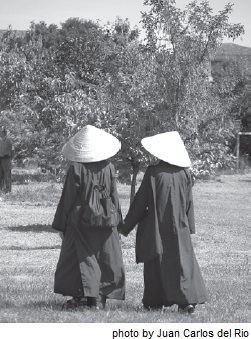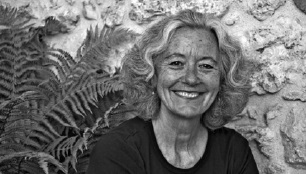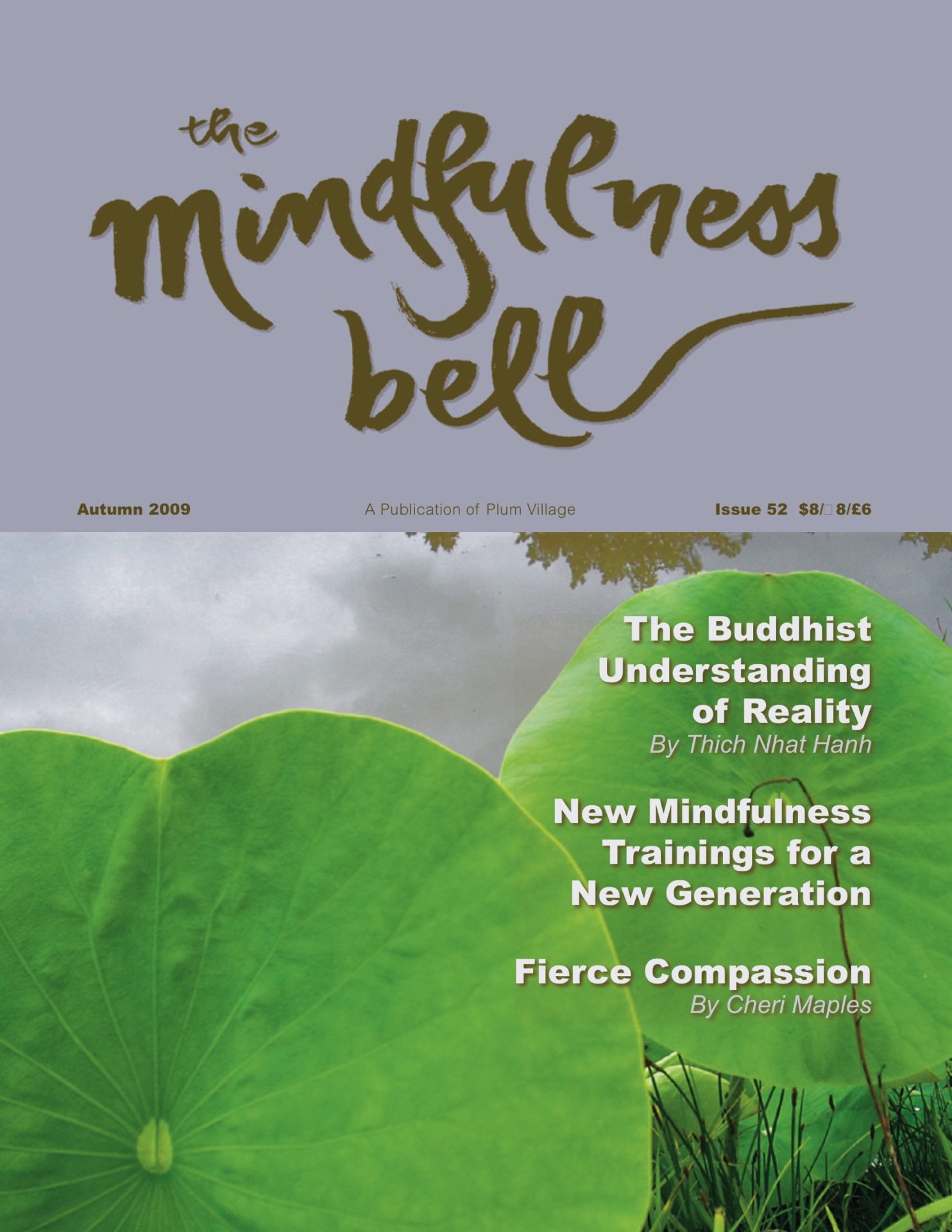Stories from a Joyful Retreat
By Lorrie Harrison

A friend recently sent a description of what he imagined it was like at Plum Village: “I get a flash of it being like individual bees flowing toward an attractant. The sweet words of Thay and the lovely people and surroundings pull at the soul like the flowers pull the bees. Then the hive disperses to various parts of the world,
Stories from a Joyful Retreat
By Lorrie Harrison

A friend recently sent a description of what he imagined it was like at Plum Village: “I get a flash of it being like individual bees flowing toward an attractant. The sweet words of Thay and the lovely people and surroundings pull at the soul like the flowers pull the bees. Then the hive disperses to various parts of the world, forever touched by the heart nectar.”
This is exactly what it is like.
A Family Reunion
About 600 of us from fifty countries are in Plum Village for the June retreat. To help people connect and feel solid, we form “families” of about twenty people. In my Oceans of Peace family, we are from Denmark, Viet Nam, Hong Kong, North Carolina, Wales, the UK, Berkeley, Botswana, Scotland, Germany, the Netherlands… and Lopez Island, my home off the coast of Washington State.
The weather is steamy-hot midday, but mornings are blessedly cool. The large pink-petal lotus flowers are just opening, a few lazy frogs lounge on the shiny green lily pads, the sun is still gentle and easy. By 9:00 a.m. we’ve all arrived at the meditation hall for Thay’s Dharma talk. Quietly we slip off our shoes and enter in noble silence. The hall is simple. At one end, two sticks of incense burn on a Buddha altar. Up front, a simple vase sits next to Thay’s cushion with a sprig of flowers and a tray with one small teapot and cup. Cushions and mats are arranged in a large semi-circle with chairs behind. I enjoy hearing the comforting rustles and whispers as lay friends and monastics settle in. Those who don’t speak English plug their headphones into audio boxes for translations of Thay’s talk.
The ting-ting-ting of the small bell announces Thay’s arrival. Everyone stands and joins their palms. Our teacher enters the silent hall and walks to his cushion in the center of the front row. He turns to the Sangha and bows. We return his bow, and all sit down.
Seeing Thay for the first time in three years, my heart opens like a morning flower. He looks so young, so fresh; his words are as joyous as his smile. “Dear friends, when I see you all here, come from so far, I feel so happy! We have each other; we have hope. Like many drops of water, we come together to flow as one serene river. On June 21 we will go back into the world, but we are here now. Let us enjoy every minute, every second. For me this is a family reunion, a celebration, a Dharma festival! We entrust ourselves to the Sangha. We learn, we grow and together are free.”
Before the monastic chanting that precedes the Dharma talk, a nun offers this aspiration: “The Sangha is invited to come back to their breathing. Let the whole Sangha breathe as one body, chant as one body, listen as one body and transcend the boundaries of the delusive self, liberating from the superiority complex, the inferiority complex, and the equality complex.”
Huh? I can understand liberating from feeling superior or inferior, but isn’t equality exactly what I’m hoping to nourish? Each morning the aspiration is read aloud and each morning I smile hearing it. The little mystery tickles me. One day, Thay unties the knots of my koan. “When we feel equal, we are still separate. Our practice is to liberate ourselves from all distinctions, to understand I am in you and you are in me. No distinctions. No separation. This is true interbeing.”
Thay talks about Barack Obama’s Cairo speech, saying President Obama is practicing Beginning Anew with Islam. “He is one of the few politicians who knows how to use loving speech. He does not call himself a Dharma teacher, but he is a Dharma teacher!” Thay tells us Obama has manifested for our sake, and asks us to give him our support. “The Sangha is very strong; we should do something to let him know we are here for him. Please reflect on how you might help him. Where there is a will, there is a way! We all know that President Obama is made of many nonObama elements.” Thay’s eyes crinkle into a twinkly smile. “And we are some of those elements!”
Breathe, You’re Online
Thay likes to write on the whiteboard when he talks. I enjoy watching him erase the board. He pauses, quietly stands up, and walks mindfully to the board. Then he picks up the eraser. There is not a sound in the Dharma hall. Hundreds of us, totally silent. It’s easy to smile, relax, and enjoy the peaceful moment. Thay slowly wipes away the words, making a clean space for new writing. I feel calm, free from speed, free from wanting anything, enjoying watching the eraser make wide, peaceful arcs across the board.
Thay is teaching about practicing right diligence: ways to stay safe in a fast world. At Plum Village, the monastics have a way to use the Internet while not getting caught in its energy. They ask another brother or sister to sit beside them while they are online. In this way they are part of the world, but safe, too. Thay paints beautiful calligraphies which are sold in the bookshop to raise money for special projects. The newest is “Breathe, you’re online.” How cool to have a teacher who, at age eighty-three, uses the Internet to share the Dharma!
A Path to Joy
One of Thay’s themes in this retreat is joy. He talks about the Buddha’s teachings on the Four Noble Truths, reminding us that the first truth is that life contains suffering. But, he says, we concentrate too much there. The second truth is that there is a path to suffering; the way we have been living has brought suffering to us. Remove the cause and the effect will vanish. The third is that there is joy, an end to suffering, and it is the absence of darkness, the presence of light. The fourth noble truth is that there is a path to that joy.
The old language, from the time of the Buddha, calls the third noble truth the cessation of ill-being, but Thay’s teaching is clear: let us call this by its true name, joy! Let’s find a way to make this wonderful teaching available to everyone. The world needs our help. “Dear friends, please be the best practitioners you can be. That is why we live our life in mindfulness and concentration: it is for our own liberation. With that, we can help to liberate the world.
We can learn to gladden our minds. Please don’t leave your love, your compassion in the basement of your store consciousness. Go get them! They will be your tonic, your strength, your nourishment. You will become stronger, and then, when pain, confusion, sadness come, you will be able to handle them.”
How do we bring up this feeling of joy? We make use of our breathing. We return to the present moment so that insight, knowledge, and awareness will bloom, and joy will be possible right away. We don’t have to be excited any more. Our joy can be calm and peaceful. This is true joy.
Circle of Friends
After the Dharma talk, we wander around the grounds. It’s nice to seek a soft patch of grass by the lotus pond or a wisp of shade. The monks show us where to pick juicy black mulberries from the trees. The nuns are selling little treats to raise money for needy children in Vietnam. We gather at their tables, choosing sweet crepes served on fat green leaves, warm sesame balls (oh, the doughy goodness!), and squares of carroty cake.
The big bell calls us for walking meditation. We gather in one huge circle, monastics and lay friends side by side. Someone begins singing, “Happiness is here and now, I have dropped my worries. Nowhere to go, nothing to do, no longer in a hurry.” More little songs follow with simple words, melodies, and hand motions. We sing in French, German, Dutch, Vietnamese, and Spanish. Years ago I felt a little goofy singing like this, but now these songs awaken my tender heart. I feel like a happy kindergartner, safe in a circle of friends.
After we sing half a dozen songs, a hush falls on the group. Like flowers turning toward the sun, the circle opens as Thay joins us. We join our palms and bow. Taking two children by the hand, he starts making slow, mindful steps. Imagine the extraordinary sight: 600 people silently walking step-by-gentle-step around the lotus pond, through the stately rows of poplar trees, into the forest, down beside the creek, and finally back to the hamlet. We walk for forty-five minutes, flowing in a silent Dharma river.
Lorrie Harrison, Compassionate Listening of the Heart, is a founding member of the Morning Light Sangha on Lopez Island in Washington State. A professional writer, she lived and practiced near Plum Village for five months over the summer.


